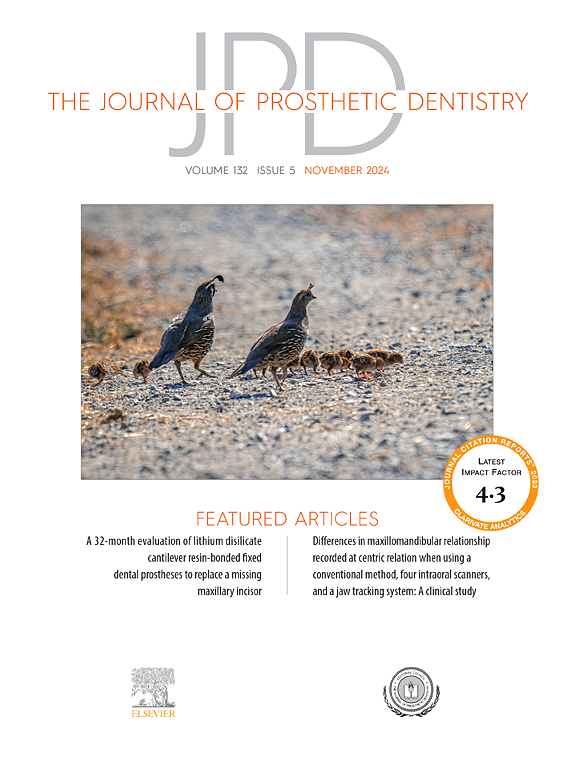Effect of using a self-etching primer to repair resinous CAD-CAM materials: An in vitro study
IF 4.8
2区 医学
Q1 DENTISTRY, ORAL SURGERY & MEDICINE
引用次数: 0
Abstract
Statement of problem
A consensus is lacking regarding the optimal surface treatment for repair protocols that ensures reliable bonding to computer-aided design and computer-aided manufacture (CAD-CAM) resin composite in intraoral applications.
Purpose
The purpose of this in vitro study was to compare the microshear bond strength promoted by 3 bonding strategies to repair commercially available CAD-CAM resin composites.
Material and methods
Three CAD-CAM resin composites (Cerasmart, Brilliant, Tetric CAD) and a hybrid ceramic (Vita Enamic) were pre-aged for 5000 thermal cycles and allocated into groups according to surface repair treatments: hydrofluoric acid etch, silane, and Monobond Etch & Prime, airborne-particle abrasion and Monobond Etch & Prime, or only Monobond Etch & Prime. Transparent Ø8×0.5-mm polyethylene tubes were placed on the treated surfaces and were filled with flowable resin composite. Half of the specimens (n=4) were microshear bond strength tested after 24 hours and the other half after thermal cycle testing, and the surface topography was examined. Data were analyzed with 2-way repeated measures ANOVA and the Bonferroni test (α=.05)
Results
After 24 hours, for the Cerasmart, Tetric CAD, and Brilliant resin specimens, the Monobond Etch & Prime strategy presented the lowest microshear bond strength values (P<.003). In the Vita Enamic group, no differences were found among groups after 24 hours. After 10 000 cycles, values decreased in all groups (P<.05). The airborne-particle abrasion with Monobond Etch & Prime strategy promoted the highest values.
Conclusions
Airborne-particle abrasion combined with a single component self-etching primer provided a simplified clinical alternative for repairing resin-containing CAD-CAM materials.
使用自蚀刻底漆修复树脂CAD-CAM材料的效果:体外研究。
问题陈述:关于修复方案的最佳表面处理缺乏共识,以确保在口腔内应用中与计算机辅助设计和计算机辅助制造(CAD-CAM)树脂复合材料可靠地结合。目的:本体外研究的目的是比较3种粘接策略对市售CAD-CAM树脂复合材料微剪切粘接强度的影响。材料和方法:三种CAD- cam树脂复合材料(Cerasmart, Brilliant, Tetric CAD)和混合陶瓷(Vita Enamic)预老化5000个热循环,并根据表面修复处理分为氢氟酸腐蚀,硅烷和Monobond etch & Prime,空气颗粒磨损和Monobond etch & Prime,或仅Monobond etch & Prime。将透明的Ø8×0.5-mm聚乙烯管放置在处理过的表面,并填充可流动的树脂复合材料。其中一半试件(n=4)在24h后进行微剪切粘结强度测试,另一半试件进行热循环测试,并进行表面形貌检测。结果:24小时后,对于Cerasmart、Tetric CAD和Brilliant树脂样品,Monobond蚀刻& Prime策略具有最低的微剪切结合强度值(pp结论:空气颗粒磨损联合单组分自蚀刻引物为修复含树脂CAD- cam材料提供了一种简化的临床选择。
本文章由计算机程序翻译,如有差异,请以英文原文为准。
求助全文
约1分钟内获得全文
求助全文
来源期刊

Journal of Prosthetic Dentistry
医学-牙科与口腔外科
CiteScore
7.00
自引率
13.00%
发文量
599
审稿时长
69 days
期刊介绍:
The Journal of Prosthetic Dentistry is the leading professional journal devoted exclusively to prosthetic and restorative dentistry. The Journal is the official publication for 24 leading U.S. international prosthodontic organizations. The monthly publication features timely, original peer-reviewed articles on the newest techniques, dental materials, and research findings. The Journal serves prosthodontists and dentists in advanced practice, and features color photos that illustrate many step-by-step procedures. The Journal of Prosthetic Dentistry is included in Index Medicus and CINAHL.
 求助内容:
求助内容: 应助结果提醒方式:
应助结果提醒方式:


